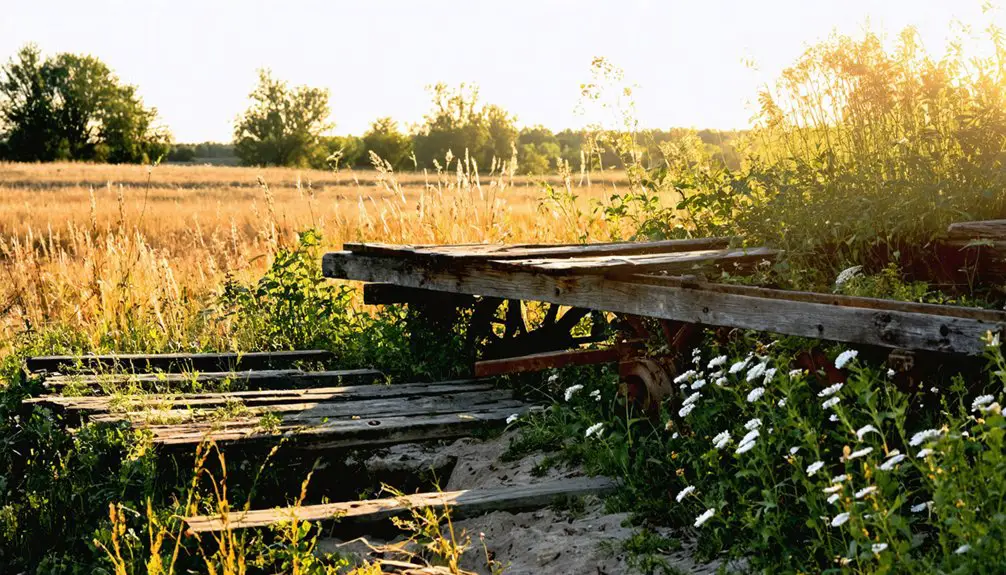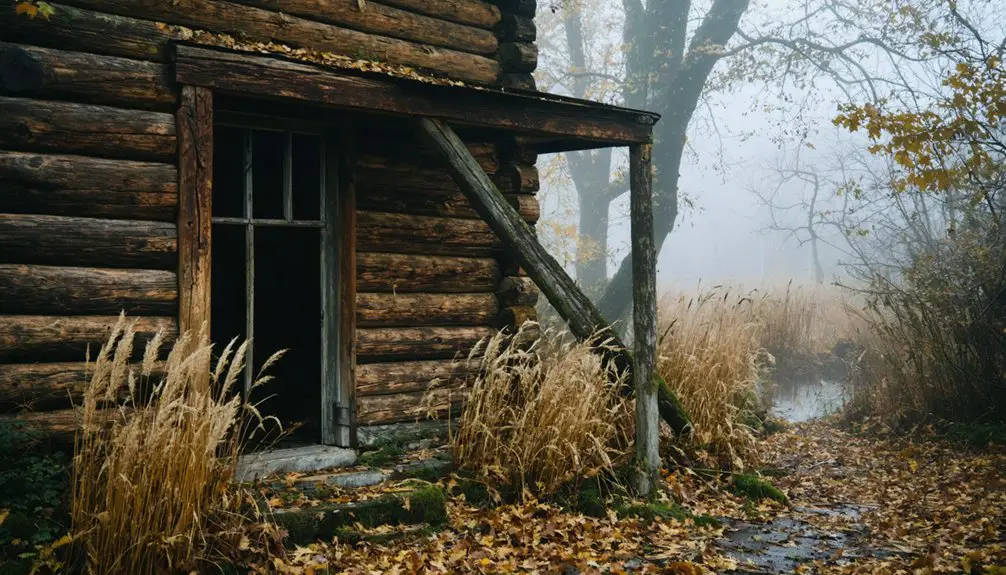You’ll find Bertrand’s ghost town remnants in southern Niles Charter Township, Michigan, where a once-thriving river trading post established by Joseph Bertrand in 1808 expanded into a bustling village of nearly 1,000 inhabitants by the 1830s. The town’s strategic location at the intersection of the St. Joseph River and Detroit-Chicago road supported multiple hotels, stores, and a post office. Today, only two historic cemeteries and one original home remain, while local legends speak of ghostly French traders and Native Americans who still walk the grounds.
Key Takeaways
- Bertrand was once a thriving Michigan trading post established in 1808, which grew to nearly 1,000 inhabitants by the 1830s.
- The town declined after the Michigan Central Railroad bypassed it and faced competition from nearby South Bend and Niles.
- Only three physical remnants exist today: two historic cemeteries and one original home, with all commercial structures now gone.
- The town’s strategic location at the St. Joseph River and Detroit-Chicago road initially fueled its growth as a trade hub.
- Local ghost stories include sightings of French traders, Native Americans, and Mary Higbee’s spirit in the old churchyard.
The Rise of a Trading Post Empire

When Joseph Bertrand married Madeline Bourassa in the early 1800s, he gained more than a wife – he secured essential access to Potawatomi lands that would transform his modest trading venture into a commercial empire.
In 1808, you’d find Bertrand establishing his official trading post along the St. Joseph River crossing, where the trading dynamics perfectly aligned with the region’s growing commerce needs.
His entrepreneurial spirit drove rapid expansion, and by the 1830s, you’d discover a bustling village of nearly 1,000 inhabitants.
From a modest trading post emerged a vibrant village of 1,000 souls, transformed by one man’s ambitious vision.
The given name Bertrand became synonymous with commercial success in Michigan territory during this period.
The settlement boasted three hotels, seven dry-goods stores, a warehouse, and a post office.
Bertrand’s strategic location on the Detroit-Chicago road made it a significant hub for Native American trade, fur trading, and pioneer traffic, cementing its position as an essential commercial center.
The rich soil of black vegetable mould in the surrounding prairie lands supported the settlement’s growth through abundant crop production.
Strategic Location Along Pioneer Routes
You’ll find Bertrand’s prominence stemmed from its position at the intersection of the St. Joseph River’s trade routes and the Detroit-Chicago road, making it a critical waypoint for early 19th century commerce.
The village’s location just 4 miles south of Niles and south of the Great Sauk Trail allowed it to capitalize on both water and overland transportation networks. The settlement’s success led to the establishment of seven dry-goods stores to support the growing community.
As river trade complemented wagon traffic, Bertrand developed into a bustling hub where travelers could find multiple hotels, taverns, and dry-goods stores to serve their needs. One notable establishment, the Steamboat Hotel, was constructed in the late 1830s to accommodate the growing number of visitors.
River Trade Convergence
Situated at a critical juncture of the St. Joseph River, Bertrand’s location made it a powerhouse in early Michigan’s trade networks.
You’ll find this strategic spot where the Great Sauk Trail crossed the river, creating a perfect storm of transportation possibilities for both Native Americans and pioneer traders.
The site’s natural advantages couldn’t have been better for river navigation, offering direct access to Lake Michigan’s shipping lanes and essential connections to the Mississippi River basin.
Early traders capitalized on the nearby portage routes, transforming Bertrand into a bustling distribution center for furs and goods.
Joseph Bertrand established himself as an influential trader in the area, leveraging the location to build his successful commerce operations.
Whether you were moving merchandise by water or land, this convergence point opened up trade opportunities in every direction, making it an irresistible location for merchants looking to tap into the region’s expanding commerce.
Detroit-Chicago Road Crossing
Building upon its river trade advantages, Bertrand gained even greater strategic importance as an essential crossing point where the Detroit-Chicago Road intersected the St. Joseph River.
The roadway significance of this location can’t be overstated – you’re looking at a fundamental transportation evolution from the old Great Sauk Indian Trail to a primary pioneer route connecting Detroit to Fort Dearborn by the 1830s.
- You’ll find the site strategically positioned about 4 miles south of Niles, making it a natural rest stop for weary travelers.
- The road brought year-round traffic, especially important during winter when Great Lakes navigation stopped.
- Early settlers established trading posts, stores, hotels, and a post office to serve the steady stream of pioneers.
- The route proved essential for military movements, postal service, and commercial activities.
- After the 1833 Treaty of Chicago, this crossing became a gateway to newly opened frontier lands.
The road was a crucial part of the early settlement period, with pioneers first traveling between Detroit and Chicago from 1820 to 1835.
The introduction of stage coach service in 1833 brought more regular traffic through Bertrand, with coaches running three times weekly along the route.
Life in Bertrand’s Golden Age
During its golden age in the early 1830s, Bertrand thrived as a bustling frontier settlement with nearly 1,000 residents, where European settlers and Potawatomi people forged a uniquely integrated community.
You’d find cultural integration exemplified through marriages like that of Joseph Bertrand to Madeline Bourassa, connecting French Canadian and Potawatomi families. Local legends tell of Bertrand’s buried treasure, consisting of a half bushel of silver coins, after he was defrauded of his lands.
Life centered around the village’s three hotels, seven dry-goods stores, and bustling post office. Community gatherings often took place at the Union Hotel, where township elections first occurred in 1836.
The Steamboat Hotel, built by Joshua Howell, became a social hub where travelers and locals mingled.
Situated along the Detroit-Chicago road and near the St. Joseph River, you’d witness a constant flow of traders, settlers, and indigenous people engaged in commerce and cultural exchange.
Economic Forces Behind the Decline
While Bertrand initially showed great promise as a frontier settlement, several economic forces converged to trigger its eventual decline. The proprietors’ inflated land prices deterred new settlers and investment, while the Michigan Central Railroad‘s decision to bypass Bertrand for Niles proved devastating. As with many historic boomtown failures, depleted natural resources and shifting trade patterns made recovery impossible.
High land prices and missed railway connections sealed Bertrand’s fate, transforming a promising settlement into another lost frontier town.
You can trace the town’s downfall to these key factors that sealed its fate:
- Excessive lot pricing by village proprietors prevented affordable expansion
- Loss of railroad access isolated Bertrand from essential trade networks
- Diminishing Native American trade removed a critical economic foundation
- Competition from South Bend and Niles drew away commerce and residents
- Chicago Treaty of 1833 shifted settlement patterns to more viable areas
The railroad impact and high land prices created a perfect storm that Bertrand couldn’t weather, while neighboring towns flourished with better transportation links and reasonable costs. Like many settlements that faced economic shifts, Bertrand’s primary industries and trade activities became increasingly unprofitable, accelerating its transformation into a ghost town.
Tales and Legends of Old Bertrand

As Bertrand faded into a ghost town, supernatural tales and local legends took root among its abandoned buildings and quiet grounds.
You’ll find stories of ghostly apparitions wandering the old churchyard at night – French traders and Native Americans appearing in the darkness while eerie music echoes at midnight.
The most famous supernatural folklore centers on Mary Higbee, daughter of founder Joseph Bertrand, whose spirit reportedly haunts the village ruins.
A popular Native American curse legend claims Bertrand’s demise stemmed from denying a man liquor in the 1830s, though historians attribute the decline to economic factors.
Even the town’s founding family wasn’t immune to myth-making – locals incorrectly portrayed Madeline Bourassa, Joseph Bertrand’s wife, as a Potawatomi princess despite contradicting historical records.
Modern Traces in Berrien County
As you explore Bertrand’s historic location in southern Niles Charter Township, you’ll find one original home still standing among newer residences, along with two preserved cemeteries – one Catholic and one Protestant.
Two historical markers commemorate the original village site, offering insights into Bertrand’s past prominence and eventual decline.
While most original structures have vanished, you can still trace the town’s footprint through documented locations of former brick yards and dry goods stores, though these exist now only in historical records and beneath modern development.
Physical Remnants Today
Today’s visitors to the former town of Bertrand will find just three significant physical remnants: two historic cemeteries and a single original home standing amid modern residential development.
You won’t discover any commercial buildings, industrial ruins, or major structural remains from Bertrand’s peak era. The cemetery significance lies in their mid-19th century gravestones and their role as the most prominent physical links to the original town.
- The Catholic and Protestant cemeteries remain accessible and identifiable
- Modern homes have replaced nearly all original town structures
- Basic road infrastructure crosses through former town routes
- Natural vegetation now covers most of the historic area
- No visible foundations or ruins exist beyond the three key remnants
Historical Markers and Records
While physical remnants of Bertrand may be sparse, the town’s history lives on through several well-preserved historical markers and records.
You’ll find two official markers recognized by Michigan and Berrien County: Marker S0286, documenting the town’s founding and development, and Marker L1363C, highlighting the historical site of Parc.
These markers’ significance extends beyond simple commemoration, offering insights into Bertrand’s role in regional fur trade and settlement patterns.
Two historic cemeteries – one Catholic and one Protestant – provide invaluable genealogical records through their tombstones and burial documentation.
You can trace the town’s diverse cultural heritage through church records preserved in Detroit archives, which detail the influential Bertrand family and other early settlers who shaped this frontier community.
Frequently Asked Questions
What Archeological Artifacts Have Been Found at the Original Bertrand Village Site?
You’ll find Native American tools, trade goods, and household items through archeological methods at this site, though artifact significance remains limited due to sparse formal excavation documentation.
How Many Descendants of Joseph Bertrand Still Live in Michigan Today?
You’d need a crystal ball and DNA test for every Michigander to count Joseph’s descendants today! While family lineage and ancestral records suggest thousands exist, there’s no definitive count available.
What Happened to the Native American Communities After Bertrand’s Decline?
You’ll find that Native rights suffered as most Potawatomi were forced west, though community resilience shone through the Pokagon Band, who maintained their Michigan homeland through Catholic ties and legal resistance.
Were There Any Documented Crimes or Murders in Bertrand’s Early Days?
You won’t find any documented crimes or murders in those early days – coincidentally, unlike other ghost towns’ crime histories and unsolved mysteries, historical records show this community remained peacefully focused on trade.
Did Any Famous Historical Figures Ever Visit or Stay in Bertrand?
You won’t find famous visitors beyond local leaders like Joseph Bertrand and Fredric Howe. The town’s historical connections centered on fur trading, Potawatomi relations, and early township politics.
References
- https://bertrandtwpmi.gov/history
- https://www.stjosephcem.org/ghosts-and-such.html
- https://berrienhistory.wordpress.com/2021/03/11/hotel-oronoko-from-bertrand-to-berrien-by-raft/
- https://en.wikipedia.org/wiki/Bertrand
- https://www.hmdb.org/m.asp?m=261108
- https://www.berriencounty.org/DocumentCenter/View/263/Bertrand-Township-PDF
- https://www.angelfire.com/mi2/miroots/michigan/berrien/bertrand.html
- http://www.wiskigeamatyuk.com/Joseph_and_Madeleine_Bertrand.htm
- https://www.ghosttowns.com/states/mi/bertrand.html
- https://archive.org/download/michiganfurtrade00johnuoft/michiganfurtrade00johnuoft.pdf



